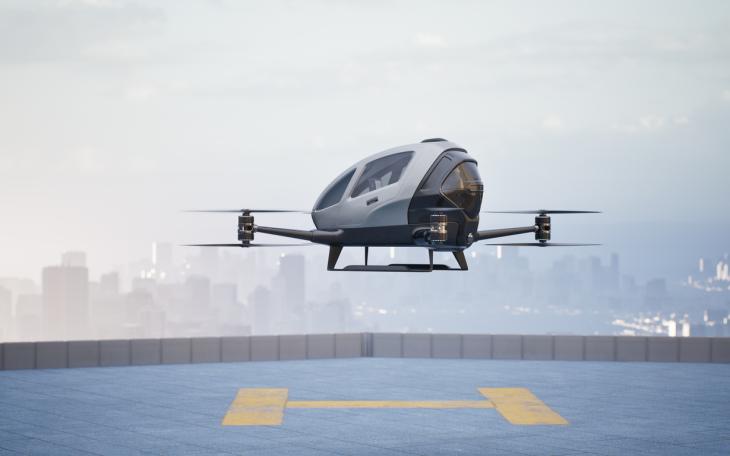“Where we’re going, we don’t need roads!”

Just over 30 years since Doc Brown uttered those immortal words to Marty McFly and it might be time to think just what it means when asking your cab driver to “drop you off just down there”.
The global aviation industry has been gathering for the Paris Air Show this week, and we are without doubt four years further into the future than at the last pre-pandemic event in 2019!
The headline reason is the advance in “flying taxis” or advanced air mobility (AAM) to give them their technical name, and the arrival in Paris of the eVTOL – the electric vertical take-off and landing vehicle. Henry Ford unsuccessfully trialled the Ford Flivver flying car in 1927, but in the 96 years that have passed since, the need for an airborne solution has only grown – ever more congestion, pollution, slow travel times and a road-based transport system that has drivers looking to the heavens for help.
The difference now is that there has been a huge amount of global investment in this market, aircraft designs have been developed, there are some big players in the sector, there is tangible ambition to deliver this slice of the future, and there is a roadmap (or should that be an aeronautical chart) to get there!
Before you dismiss this as the science fiction of the future, prepare to look to the skies as early as next year. Germany’s Volocopter is aiming to be the first company to offer commercial flights in Europe, in time for the Paris Olympics in summer 2024. Their initial VoloCity two-seater model will only carry one passenger and have a range of 35km, but it will be silent, emission-free and failure-proof, powered by a circle of 18 identical electric motors.
Meanwhile across the Atlantic, and it is Archer Aviation who will take to the skies next year, as the California-based operator moves into the active testing phase of their Midnight model, when they predict more than six piloted planes travelling around Silicon Valley each day. This model will carry four passengers (plus the pilot), have a range of 160km and reach a top speed of 240km per hour. Their ambition is that by the time of the Los Angeles Olympics in 2028 there will be as Chief Executive Adam Goldstein described it “hundreds or thousands” of these aircraft taking to the skies.
These are not the only two companies leading the way and there are at least six aircraft models that should be appearing in different parts of the world over the next 18-24 months. The list of investors and backers is a roll-call of major players across the aviation, automotive, tech and finance sectors – Joby Aviation is backed by Toyota, Blackrock and Uber, Vertical is backed by the UK Government, Honeywell and Virgin Atlantic, while City Airbus is backed by the German Federal Government and Munich Airport.
Some analysts predict that the global market could be worth $1tn by 2040 but change will not happen overnight. The manufacturers will need to resource for mass production, while tackling outstanding questions about safety, battery reliability and cost. The operators will need to consider the cumulative impact of lots of air taxis on noise levels and how they will source sufficient landing spots, not only for ease of use by passengers but also for safe recharging of batteries – it might be frustrating when your Tesla runs low on charge, but fundamentally it is not likely to fall out of the sky!
Then after all this, the fundamental issue is how governments and regulators react – and as a public affairs professional, this is my favourite part. As it stands, none of the above aircraft have been certified by the regulators. Vertical received a preliminary approval from the British Civil Aviation Authority earlier this year, while Joby and Archer will be competing for the first US certification in 2024. Volocopter who have that ambitious target for the Paris Olympics are also targeting certification by the European Union Safety Aviation Agency (Easa) by the end of the second quarter in 2024. Easa and the Federal Aviation Authority have each published some guidance on safety requirements and are collaborating on standards to allow companies to operate in both regions.
Beyond certification, there will be questions around pilot training, working hours, and once governments are involved, there will be issues of taxation and licensing costs – especially if lucrative taxation yields from roads are depleted. While London is locked in an argument over ULEZ now, fast forward ten years and we might be considering localised Ultra Low Aircraft Zones!
Inevitably, this technology does not end with flying taxis and there are already suggestions that the emergency services could benefit greatly from the speed and agility of such vehicles, but how long will it take before the demand filters through to calls for individual private ownership and aircraft-pools on new housing developments, which would of course be designed with communal hangars rather than garages? In the meantime, the opportunities for opportunistic criminal activity and quick evasion of traditional law enforcement will necessitate a new branch of flying police to tackle a new era of threats. As with AI now and the internet 40 years ago, we can still only imagine the limitations and challenges of this new technology – but whatever our hopes or fears, this change is real, and it is happening now.
The largest global air show alternates between France and the UK each year, so next year Farnborough will play host to the next collective industry chapter in designs and aircraft, and if the manufacturers are on target, 2024 could be one of the most significant years for aviation for a generation.
Next time you are waiting impatiently for your congestion-bound taxi to arrive, remember the words of the most famous movie taxi driver Travis Bickle, “Anytime, anywhere” and look to the skies, because the future is coming!









